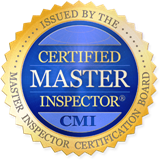

Certified Master Inspector
Providing Residential and Commercial Property Inspections for Muskoka
8 a.m. to 7 p.m., 7 Days a Week
Call 705 205 4663
DoneRight1@live.ca
8 a.m. to 7 p.m., 7 Days a Week
Call 705 205 4663
DoneRight1@live.ca


There seems to be a great deal of confusion among home buyers about E&O insurance and how it applies to both the real- estate transaction and to the home inspection. Most consumers are aware of the term Error & Omissions insurance through articles in home buying magazines or from one of the many TV shows on homes and renovations. Most consumers are also aware that real estate agents have had E&O as standard for some time now. They can also see some home inspection firms are advertising that they carry E&O as well. The confusion about E&O comes from the mistaken belief that E&O insurance is there to protect the home buyer from mistakes-Errors, and things missed or left out-Omissions. Years ago and long before home inspections, I myself was told by a realestate broker I think highly of that E&O was there to protect me in case she missed something in the paper work. That seems to be the stock answer to the question in the realestate profession and now it has spread to the home inspection industry as well. As a home, cottage , and commercial inspector in Orillia, Gravenhurst, and all of Muskoka I have received many inquiries over the last ten years about E&O from clients. They will ask me if I carry it and tell me that so and so has it to protect me do you? When I explain exactly what E&O insurance is and how it works, many are surprised a few are even shocked.
As shocking as it may be, any professional, lawyers, engineers, realestate agents, brokers, and home inspectors may carry Error and Omission insurance policies, but not to protect the consumer. They carry E&O to protect themselves. In simple terms, E&O insurance is a policy ( agreement ) whereby the insurance company agrees that for a specific sum paid by the professional, the company will provide legal assistance and coverage (protection) of up to an agreed upon limit to remediate damages. However, only if the professional makes an unintentional and provable mistake or omission within the standards of practice for the profession. There are two parties in this transaction, the insurer and the professional. The insurance is clearly there to protect the professional from someone who is making a claim against them for sums they do not have or claims that are fraudulent.
This is exactly the same setup as the liability insurance you carry on your home insurance. You are the insured or protected party. For an agreed on sum the insurance company agrees to protect you and your assets against possible claimants, but only if and when the claimant can prove the injury, and if they can prove it happened on or in your insured location.
If E&O existed to protect the home buyers then they would be the insured client. E&O would be insurance against specific perils ( errors and omissions of their inspector) that the home buyer could buy that would protect them. They would pay the premium and after proof of a claim they would be paid by the insurer. This would be the same setup as home fire insurance or your car theft insurance.
The short answer is a resounding no, with one very small exception. To illustrate I give you the following: If you have a person slip and fall in your snow covered driveway, they may choose to make a claim. This is the same as a home buyer might make a claim against a realtor, ie. a realtor who might forget to get expensive things included in the purchase contract the buyer asked for. It is also similar to a home buyer who might claim against a home inspector who missed reporting aluminum wiring in the home. In all these three cases the claimant would normally first approach the other party with the complaint and try to resolve it. A reasonable home owner, or a good home inspector or real estate agent will deal with this matter and resolve it right here. Only after not getting the response they are looking for would the person making a claim themselves or with the aid of legal assistance approach the insurer. The insurer would investigate the claim by asking the claimant to prove by document and witness it did occur, they will then attempt to determine if the insured is at fault or in any way responsible. Often if it was a provable claim for a small amount (usually just over the deductable) The insurer would inform their client they must pay the deductable and they will pay the small balance to settle it. You remember from buying your home and car insurance the larger the deductable the lower the cost of the insurance, that is because claims for amounts smaller than the deductable do not overly concern insurers, somebody else is paying and it will not affect their profit line. Ok, so the homebuyer may be able to collect a small amount if something goes wrong, what protection does the homebuyer have if something major is missed or forgotten?
The real answer is very little or none. Using the same slip and fall scenario, forgotten inclusions, or unreported aluminum wiring examples, let’s say the claim was for a large amount. Perhaps the claim would be into the multi thousands of dollars. If we assume that the claimant was able to offer some proofs required, the incident did take place, the inclusions were discussed, the wiring should have been seen etc. the claimant must also prove damages. The accident made me loose work worth x, the items cost x to get, the wire cost x to replace. Even assuming the claimant believes those loses could be proven, there is one abiding principal involved to make note of. Insurance companies must, like any business, make a profit to survive. Profit is the insurance company’s only real asset. The profit any insurance company makes comes to the company from fees left after claims that it does not pay to claimants.
The client / insured relationship does not exist to help or protect the claimant. Instead, it exists to pay the professionals legal fees (if in any way justified) to oppose the claimant (read you ) and to protect the insurance companies and the insured’s assets from the claimant. Clearly the insurance company is in direct oppisition to the claimant. Now if we assume that a question on any part of the proof of claim or proof of loss comes into play, well, so much for the claimant getting any satisfaction from the E&O insurance. You must remember that not paying claims benefits the insurance company so it is in their best interest to put up any roadblocks they can. Insurance companies have had hundreds of years of practice and hundreds of thousands of cases to learn from. Insurance companies ave become very good at opposing claims. They are, next to banks, the most successful businesses in the world. Contracts are carefully written to protect themselves and their clients.
When the loss can be proven and the value of the loss assessed, the claimant must finally prove the other party is at fault for the loss. Did the homeowner have a duty to clear the snow from the driveway? Was it still snowing when the fall took place? Is it unreasonable to believe that the walker should have been more careful when walking on a snow covered driveway? There are literally hundreds of questions to be answered prior to the insurance company assuming any fault and most of them are designed to reduce the claim to as little as possible. In the case of a home inspector missing aluminum wiring, was it visible to him, or was it covered in insulation, behind drywall, or otherwise obscured from view. Did the home seller somehow hide it from view or not disclose it as they are required to if they know. These and many other questions would come up during the insurance company’s investigation. All the questions are designed to give the insurance reason to pass on responsibility for some or all of the claim and to pay out nothing or as little as possible to the claimant. E&O insurance offers little in protection to a homebuyer, its not meant to.
When I explain exactly what E&O insurance is and how it works, too many are surprised that E&O isurance is not there to protect the homebuyer, it is there to protect the assets of the client and the insurance company. I hope this helps explain the truth about E&O insurance coverage.